Systems Thinking For Contractors
- In Your Marketing, Contracting Business & Life
Once you see this and understand it, you’ll be able to understand reality in its entirety.
Systems thinking, like the name says, is a way of thinking. Instead of viewing things from one angle you’re viewing things as a whole.
It’s like taking the red pill in the Matrix.
Mind you, this is not your regular reading.
This is intellectually challenging and thought-provoking. It completely changed how I view all things in my life. My body, my family, marketing, my business, all of it.
There’s a serious commitment you’re undertaking in reading this. You may need to come back to re-read it a few times to fully grasp the concepts.
Not because there’s anything wrong with you, but because nobody ever opened your eyes to the whole scenery.
If you read till the end, I can promise it will offer a whole different shift in how you view marketing in your contracting business.
If marketing was ever a challenge till now… you’ll soon have competitors wonder whatever happened that you left them all behind.
This is your last warning…
Once you go deep, there’s no turning back. Once you understand it, your worldview changes.
Ready?
Let’s go!
Linear Thinking, The Current Perspective
Before we go deep into systems thinking, let’s take a look at how we view the world right now.
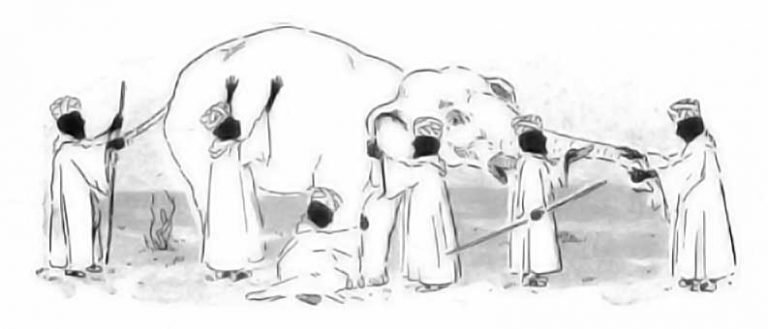
The blind men and the elephant
There’s a great Indian parable that talks about 6 blind men being taken to an elephant. They each touched the elephant in a different spot.
One touched the side and said, “it’s a wall”.
The other touched a leg and said “it’s a tree”.
The third one touched the ear and said “it’s a fan”.
The fourth one touched the trunk and said “it’s a snake”.
The fifth one touched the tail and said “it’s a rope”.
The sixth one touched the tusk and said “it’s a spear”.
And so these men of Indostan
Disputed loud and long,
Each in his own opinion
Exceeding stiff and strong,
Though each was partly in the right
And all were in the wrong!
That’s what most of us do. We go through life without seeing the whole picture.
We see parts of the system and treat them individually…
Let’s take a look at 2 more examples of linear thinking, one in life, and one in marketing.
Linear thinking in marketing
All gurus will have you believe that in marketing… if you touch one point in your marketing (usually the one they’re selling) – you’ll achieve massive growth.
You’ll be an expert marketer.

Or you’ll see a bullshit funnel picture like the one below.

So if you focus on traffic, you’ll definitely get more leads that you’ll be able to “convince” and eventually convert. And in the end, some of those leads will become a referral.
How convenient, right?
The theory goes that if you increase ANY of the steps, you’ll win big.
If you convert 10% more traffic into leads => WIN
If you “just” increase your sales close rate by 5% => WIN
If you can get 3 more customers to refer you => WIN
If you “just” do X tactic that gets you Y from the process you’ll win.
Just one more hack. One more trick. One more never seen before “secret” that will blow up your sales.
And if you had a little skin in the game till now, you very well know how that works, right?
It doesn’t.
Because of the intimate connections in a system, a connection that is further down the road may be affected by the first step.
For example, you won’t be able to close 5% more people even if you increase traffic by 1000% – if that traffic isn’t qualified.
We’ll come back to marketing in a sec.
Linear Thinking In Life
James Clear is one of the biggest personal development speakers and a bestselling author.
He describes the concept of The Four Burners Theory.
Imagine a stove that has 4 burners. One is family, one is friends, one health and one work.
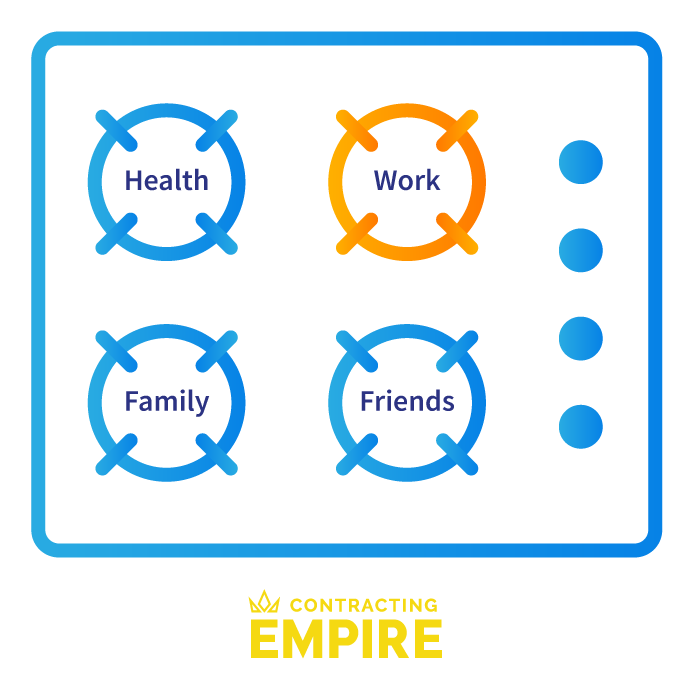
The theory goes that if you turn one-off… you’ll be successful. If you cut two, you’ll be really successful.
Because this is classical linear thinking. Without taking into consideration the connection between the burners is dead wrong. Sorry, James.
How many times have you ever tried to light only one up?
You lit your business with a huge & bright flame. Proud and strong.
Saying you’ll make it right by your family – later.
You’ll make it right by your health – later.
You’ll have more time to connect with friends too.
Only when you get your business to work. Only when you make enough money will you have time for the rest of the “burners”.
How did that work out for you?
For me it was terrible.
I spent 14h+ per day at the office. Slept whenever I could on the couch. Sometimes I fell asleep with my head on the keyboard only to wake up with a headache and the keys imprinted on my face in the morning.
In a constant state of delusion. That I was “doing the work”. Grinding. Hustling.
F$%K THAT!
I’m ashamed to write this, but for the first 3 years of their life… my wife raised the kids by herself.
I was stuck in self-destruct mode.
Things changed when I understood systems thinking.

How actually all the parts are actually interconnected. And how I can grow the whole system.
Burn all 4 burners at the same time without having to put out any and thrive.
I’ll get back to the solution in a bit.
Expanding Linearity With Feedback Loops
Let’s take a look at how things unfold concerning the increase and decrease of population.

So the more people get born, the more population. And the more people there are, the more people die.
How about marketing?
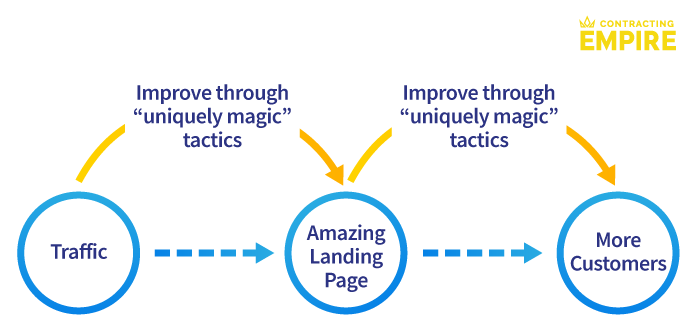
Whatever you improve, you’ll get compounding growth.
Seems sexy. Doesn’t work in reality.
In reality, a system follows laws and principles. Like gravity. Or Newton’s third law of motion (to every action there is an equal and opposite reaction.)
And that’s where feedback loops come in.
They provide the system with either growth or balance.
For example, the more people are born, the more population. But the more population there is, the more people will get born.
This is a reinforcing loop.
At the same time, the more population, the more deaths. The more deaths, the fewer people will be born. This is a balancing loop.

So our system starts to paint a complete picture of what’s going on.
Now add on top of that:
– resources per person
– life expectancy
– desired family size
– births per person
– delay between action and reaction…
And other variables and you start seeing the complexity of the system.
It’s all but linear.
This article focuses more on how you can leverage systems thinking than the theory behind it.
Feedback loops in the contracting business
Let’s look at a typical contracting business that is starting out and starts off by leveraging referrals. When you start out, referrals are mostly friends and family.

In the image, you can see that your Business generates Referrals. Now you’re generating some referrals.
If your referrals refer more than 1 person to your business then you would have a reinforcing feedback loop.
The usual scenario though is that you’ll only get a handful of people that will refer new people to your business.
Unless you ask, which increases your chances dramatically.
Otherwise, you’re actually in a balancing loop. And at one moment in time, you’ll run out of referrals. That’s when people usually start to scramble and try the next shiny thing and promise.
You can see a more complete view of the system below.
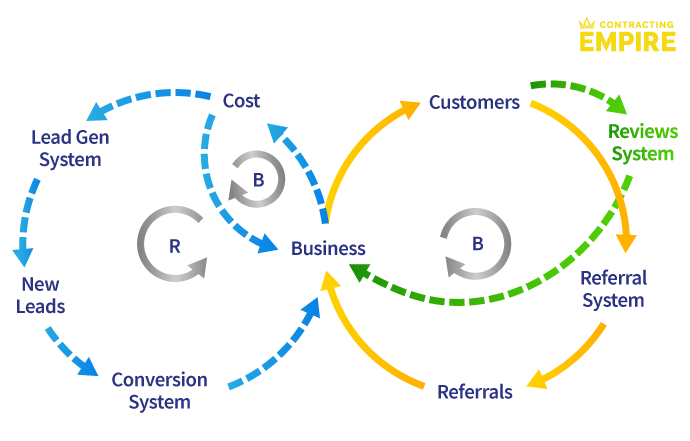
To offset the balancing effect of the referral loop we need to introduce a reinforcing loop in the system. One that will create a constant flow of new leads.
But this will usually happen at a cost. Which is either time or money.
That process will end up generating some new leads that may become customers. Then those customers can become new referrals.
Obviously this system is much more complex than what I’ve drawn here. There’s a whole block missing on how those new leads turn into customers in the business.
Cost is part of a bigger system called economics.
It’s a simplistic view of how things are interconnected.
Feedback Loops In Your Life
I remember having the same conversations going over and over and over again with my wife. Perhaps you get some of these in your life as well.
I’m not there for the kids.
I’m not there for her.
I don’t care.
All I think about is work.
Blah blah blah.
The outcome was always the same.
We ended up being frustrated and things didn’t seem to lead anywhere.
And the next time the discussion showed up, we went through the same process again. And again… and again.
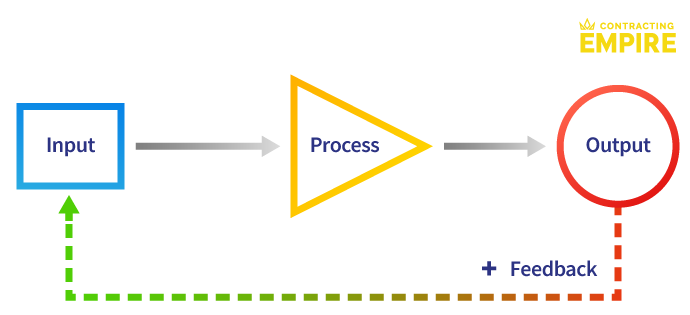
If we are to put my conversations in a system, we have:
- An input (the topic of discussion)
- The process (the discussion)
- Output (wife cries, I’m angry and frustrated)
The magic happened when we introduced a feedback loop into the system.
My wife started asking what were our takeaways from the conversations. What did we get out of it?
Each time we were able to articulate what we actually wanted instead of focusing on the negative. And the next time we started a conversation, we had an improved input to our system.
In a year our conversations have improved dramatically. There was no more reproach. No more anger. Only positive conversations looking at positive outcomes on how to go through a different challenge.
Together.
So next time you’re having a conversation with someone, ask what the other person’s takeaways were. And share yours.
What have you learned from the interaction? What’s the takeaway?
A System Is A Product Of Its Interactions

A system is a place of interconnectedness.
All its nodes have a relationship with one another. All nodes are connected through non-linear connections to other nodes. And some nodes provide feedback loops to other nodes.
It’s a “living organism”.
Like any living organism, the system is not the sum of its parts. It’s actually the result of its interactions.
Read that again, it’s important.
For example, you’re kept alive by the fact that all your vital organs interact with one another.
You wouldn’t function better with two hearts.
In systems thinking a core principle is that:

A node is never improved unless it makes the whole system better.
Breaking Systems
Like I mentioned above, gurus will have you think that if you grow one part of your business, you’ll thrive.
The next shiny object that will get you your desired outcome.
In systems thinking, when you grow only one part of a system the whole system gets worse or stops working altogether.
Wait, what?
Take for example a Prius. Now you want that Prius to have more torque. You slap on a Ford F150 engine on that puppy and realize that the system broke.
The truck engine doesn’t fit. The connections don’t work.
You broke the system and the car “died”.
To find out what’s going on in a system, you can analyze the nodes of a system. Focused in and studied.
This is the default in marketing nowadays as it’s easier to simplify than expand.
The flaw is that when you analyze a node, you do it individually. And not as part of the whole system.
You’re looking at the engine, but you aren’t looking at the connections to the engine.
For example, we study how a landing page gets email subscribers. Or the traffic that ads bring in and at what price. Or how many people submitted a quote request.
But we don’t look at:
- How qualified are those email subscribers?
- How good is that traffic that’s coming in?
- How likely to buy now are the people that submitted the quote request?
- How are these individual parts interacting and how does it help the system?
What we need to do instead is a synthesis.
Shift our focus on the relationship between the parts of the system.

Considering a magical "hack" that works...
Getting back to improving one part of the system and breaking it.
Image you get a sudden increase in quote requests from 3 a day to 60 after a successful paid ads campaign.
Because you won’t have the physical time to respond to those quote requests on time, people will be left with the wrong impression.
You’ll be in a hurry to jump from one call to the next.
You’ll be forced to do rush consultation visits so you don’t disappoint.
In the end, instead of having the desired effect, the system breaks.
You end up creating a negative customer experience.
See how that works? As everything is interconnected, the system as a whole suffers.
The shift you need to make is to embrace the chaotic nature of systems.
Look at the interconnected relationships between nodes and the feedback loops your system has.
That’s why working 14h+ a day doesn’t work. You break the other parts of the system.
Sometimes irreversibly.
What's the role of systems?
Contrary to linear connections, systems thinking looks at all things as a whole.
And the purpose of a system is to serve a function.
For example, the function of a car is to take you from point A to B.
Disassemble it and you’ve got pieces of a car. The windshield won’t take you from point A to B. The engine won’t either – by itself.
The function of the “human body” system is to keep you alive.
You live in the system to reproduce and serve a function in the “family” system.
Your family is part of a system called “community” where you serve a certain purpose (function).
The community system is part of a larger town/ city system where it serves a function.
And so on.
You get it.
Basically, as you view more of the system, you realize that parts of it become sub-systems. Or the system you’re analyzing is a piece of a larger system.
All systems serving a function.
In this whole scenario, you can choose to be a “vegetable” in the system as a whole, or serve the system and thrive with it.
For example, I like to get involved in the local entrepreneurial community. Help students that are curious about entrepreneurship discover what it’s all about.

I teach them about marketing, how to think about money, and how to upgrade their mindsets.
Do you think the system thrives when more students succeed in generating wealth and making a contribution themselves to the system?
100%!
Systems do not follow the win-loss scenario. Meaning that if you get wealthy somebody else has to get poor.
Systems thrive on win-win.
You can achieve wins through reinforcing loops. The default loop will always be a balancing one.
The Death Of A System Component
There’s a book called Principles. Written by Ray Dalio – Founder, Co-Chairman and Co-Chief Investment Officer of Bridgewater Associates. He’s got a cool net worth of $18.6 billion.
In it, he explores a lot of mental models and ways on how someone can understand systems thinking better.
One quick way to understand how systems grow, thrive, and die is by looking to nature. Study it to learn how reality works.
Here are a few pointers:
1. Don’t get hung up on your views of how things “should” be because you will miss out on learning how they really are.
2. To be “good,” something must operate consistently with the laws of reality. And contribute to the evolution of the whole - that is what is most rewarded.3. Evolution is the single greatest force in the universe. It is the only thing that is permanent and it drives everything.
4. Evolve or die.
Ouch.
The last one hit hard for me. It got me to be more aware of what I’m doing and how I’m evolving.
But there’s a caveat.
When you’re trying to build muscle, you go to the gym. To build more strength and lift heavier weights you train with smaller weights at first.
And in time you add heavier weights. You build more muscle. You grow & evolve.
The same is true for your system as a whole.
You can choose to go through the “pain” and grow slowly or risk being stuck in a forever loop where nothing ever happens.
But it’s comfortable.
An indirect lesson I learned from my father and came to learn from others that I’ve crossed paths with is that if you stop growing, you start dying.
At the end of his life, he became a bitter bitter man. Grumpy and dissatisfied with how everything and everyone was.
Never looking inside.
Consider how hard it is to change yourself and you'll understand what little chance you have in trying to change others.
Jacob M. Braude
Although hard, change always starts with you.
On the other hand, people like Elon Musk, Jeff Bezos, Grant Cardone, and other older people inspire me. It’s like the more they age, the better they look.
Bad-ass! Toned up body at 65? Where do I sign up?
Follow people that inspire you to evolve.
It will be uncomfortable. It won’t be easy.
But you won’t die.
While average people see world-class performers’ successes as a matter of intelligence or luck, champions know sustained concentration of thought and action are the true key to their success.
Steve Siebold
Growing A System
So how do you actually evolve? How do you grow a system?
One of the methods was mentioned above.
You grow parts of the system with intent.
Through pain and discomfort most of the time.
Getting back to the four burners theory…
Now that we understand how systems thinking works and we understand that for your function to live, you need to evolve and thrive.

For that, you need all 4 burners turned on.
There’s no work-life balance.
There’s only life. Or death.
And the way to evolve is to grow each flame with the outlook of growing the system as a whole.
At first, I reduced the flame of my business a bit. Turned up the flame on my family burner.
Reduced the business flame a bit more and turned up the heat even more for my family and lit the flame for health.
As soon as all burners were on, I found myself in a new reality.
You see, evolving, I found a new me.

The current version of myself is nothing like the old version.
That only had one burner on. A version that was far from successful. A fat and unhealthy one at best.
And I transformed my business from the ground up.
Let’s see how you can transform yours.
The Function Of Your Business
Now for the toughest question:
What function should your business serve in the system?
Let’s say the function of your business system is to make you money.
Cool.
But where does that money come from? It comes from people. It comes in the form of an exchange. You trade your time, expertise, and service for money.
At the same time, you have to spend money on materials, ads, employees, and other stuff.
So money can’t be the function. It’s a node in the economic system in your business.
When thinking about the function of the system we need to look at the complete picture.
The function of a system is the result of the interactions of all its parts.
I love the idea that André Chaperon brought up in his systems thinking email that inspired this whole post.
He proposed that the function of our business system is to make customers happy.
With a huge emphasis on happy.
Having a bunch of disgruntled customers knocking at your office door won’t evolve your business.
But once you optimize for happy customers, the whole perspective shifts.
Instead of looking for the money… You start looking at ways to attract, earn the trust, and serve a happy customer to the best of your abilities.
- You start putting yourself in their shoes to understand what they need
- You practice empathy to understand their concerns
- You address them like someone you care about
- You genuinely want to help them
- You wouldn’t offer them anything that you know would do them a disservice
- You would charge a fair price
- You’re fully transparent
Focusing on what you can bring to the system.
When you add value to the system as a whole, your rewards start showing up.
Just to be clear, you should not charge less for a job and then get frustrated that they’ve asked for the sun & stars.
The price should reflect a system that’s thriving and evolving.
And as the system evolves, so should your prices.
Deciding To Go With Happy Customers As The Function Of Contracting Empire
Embracing the happy customers mantra was one of the best things I ever did.
By looking out for your needs, I feed my own system. We both thrive.
It’s a win-win.
The quickest win I can get you as a customer and make you happy is to create a website for you that attracts and earns the trust of your customers.
Of course, there are marketing elements infused. Of course, the site needs to load fast. Of course, it radiates professionalism and transposes a part of your business’s soul online.
It evolves your business.
Because it’s a system.
At the same time, it’s useless if your part of the system neglects customers. It doesn’t serve the function of happy customers.
Suppose you don’t pick up the phone if you’re not interested in helping those people.
We also help you serve your customers.
Through our SEO service for contractors, we can translate your voice into a helpful collection of “guides” that serve your customers 24/7.
Win-win!
Your Journey Has Only Begun
My hope is that you’ll embrace the happy customers mantra and make the world a better place.
Serve a higher purpose in the system by thriving and evolving.
We’ve only scratched the surface and there are many other key concepts in systems theory. I’ve covered what I considered the most helpful and applicable to get started.
If you ever feel going down the rabbit hole, you can check out this Wikipedia Article. Or this free course that goes through both more theory and practical application.
My soft ask
If you know someone that would benefit by reading this article, please forward it to them.
Besides growing your topics of conversation with them you’d be helping us help other contractors too.
Thank you!


Article by Eduard Boka published on November 2020
An entrepreneur since 2004, he eats marketing for breakfast, lunch, and dinner.
His biggest skill is transforming his own expertise (from working with big businesses, and huge projects) into an applicable form for contractors.
Helping them win big, fast, and long-term.

